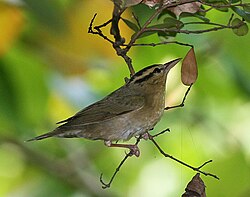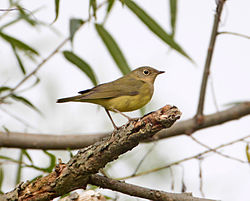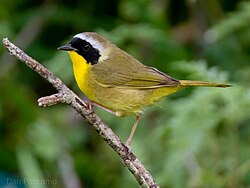| Image | Genus | Living species |
|---|
 | Seiurus Swainson, 1827 | |
 | Helmitheros Rafinesque, 1819 | |
 | Parkesia Sangster, 2008 | |
 | Vermivora Swainson, 1827 | |
 | Mniotilta Vieillot, 1816 | |
 | Protonotaria Baird, 1858 | |
 | Limnothlypis Stone, 1914 | |
 | Oreothlypis Ridgway, 1884 | |
 | Leiothlypis Sangster, 2008 | |
 | Leucopeza Sclater, 1876 | |
 | Oporornis Baird, 1858 | |
 | Geothlypis Cabanis, 1847 | - Common yellowthroat, Geothlypis trichas
- Belding's yellowthroat, Geothlypis beldingi
- Altamira yellowthroat, Geothlypis flavovelata
- Bahama yellowthroat, Geothlypis rostrata
- New Providence yellowthroat, †Geothlypis rostrata rostrata (extinct: 1990s?)
- Olive-crowned yellowthroat, Geothlypis semiflava
- Black-polled yellowthroat, Geothlypis speciosa
- Masked yellowthroat, Geothlypis aequinoctialis
- Southern yellowthroat, Geothlypis velata
- Black-lored yellowthroat, Geothlypis auricularis
- Chiriqui yellowthroat, Geothlypis chiriquensis
- Gray-crowned yellowthroat, Geothlypis poliocephala
- Hooded yellowthroat, Geothlypis nelsoni
- MacGillivray's warbler, Geothlypis tolmiei
- Mourning warbler, Geothlypis philadelphia
- Kentucky warbler, Geothlypis formosa
|
 | Catharopeza P.L. Sclater, 1880 | |
 | Setophaga Swainson, 1827 | - Plumbeous warbler, Setophaga plumbea
- Elfin woods warbler, Setophaga angelae
- Arrowhead warbler, Setophaga pharetra
- Hooded warbler, Setophaga citrina
- American redstart. Setophaga ruticilla
- Kirtland's warbler, Setophaga kirtlandii
- Cape May warbler, Setophaga tigrina
- Cerulean warbler, Setophaga cerulea
- Northern parula, Setophaga americana
- Tropical parula, Setophaga pitiayumi
- Magnolia warbler, Setophaga magnolia
- Bay-breasted warbler, Setophaga castanea
- Blackburnian warbler, Setophaga fusca
- American yellow warbler, Setophaga petechia
- Chestnut-sided warbler, Setophaga pensylvanica
- Blackpoll warbler, Setophaga striata
- Black-throated blue warbler, Setophaga caerulescens
- Palm warbler, Setophaga palmarum
- Olive-capped warbler, Setophaga pityophila
- Pine warbler, Setophaga pinus
- Myrtle warbler, Setophaga coronata
- Audubon's warbler, Setophaga auduboni
- Black-fronted warbler, Setophaga auduboni nigrifrons
- Goldman's warbler, Setophaga goldmani
- Yellow-throated warbler, Setophaga dominica
- Bahama warbler, Setophaga flavescens
- Vitelline warbler, Setophaga vitellina
- Prairie warbler, Setophaga discolor
- Adelaide's warbler, Setophaga adelaidae
- Barbuda warbler, Setophaga subita
- Saint Lucia warbler, Setophaga delicata
- Grace's warbler, Setophaga graciae
- Black-throated grey warbler, Setophaga nigrescens
- Townsend's warbler, Setophaga townsendi
- Hermit warbler, Setophaga occidentalis
- Golden-cheeked warbler, Setophaga chrysoparia
- Black-throated green warbler, Setophaga virens
- Yellow-rumped warbler, Setophaga coronata
|
 | Myiothlypis Cabanis, 1850 | - Citrine warbler, Myiothlypis luteoviridis
- Santa Marta warbler, Myiothlypis basilica
- White-striped warbler, Myiothlypis leucophrys
- Flavescent warbler, Myiothlypis flaveola
- Gray-headed warbler, Myiothlypis griseiceps
- White-rimmed warbler, Myiothlypis leucoblephara
- Black-crested warbler, Myiothlypis nigrocristata
- Pale-legged warbler, Myiothlypis signata
- Buff-rumped warbler, Myiothlypis fulvicauda
- Riverbank warbler, Myiothlypis rivularis
- Two-banded warbler, Myiothlypis bivittata
- Cuzco warbler, Myiothlypis chrysogaster
- Choco warbler, Myiothlypis chlorophrys
- White-lored warbler, Myiothlypis conspicillata
- Grey-throated warbler, Myiothlypis cinereicollis
- Grey-and-gold warbler, Myiothlypis fraseri
- Russet-crowned warbler, Myiothlypis coronata
|
 | Basileuterus Cabanis, 1848 | - Golden-crowned warbler, Basileuterus culicivorus
- Three-banded warbler, Basileuterus trifasciatus
- Rufous-capped warbler, Basileuterus rufifrons
- Chestnut-capped warbler, Basileuterus delattrii
- Golden-browed warbler, Basileuterus belli
- Black-cheeked warbler, Basileuterus melanogenys
- Pirre warbler, Basileuterus ignotus
- Three-striped warbler, Basileuterus tristriatus
- Yungas warbler, Basileuterus punctipectus
- Black-eared warbler, Basileuterus melanotis
- Tacarcuna warbler, Basileuterus tacarcunae
- Fan-tailed warbler, Basileuterus lachrymosus
|
 | Cardellina Bonaparte, 1850 | |
 | Myioborus Baird, 1865 | - Painted whitestart, Myioborus pictus
- Slate-throated whitestart, Myioborus miniatus
- Brown-capped whitestart, Myioborus brunniceps
- Yellow-crowned whitestart, Myioborus flavivertex
- White-fronted whitestart, Myioborus albifrons
- Golden-fronted whitestart, Myioborus ornatus
- Spectacled whitestart, Myioborus melanocephalus
- Collared whitestart, Myioborus torquatus
- Paria whitestart, Myioborus pariae
- White-faced whitestart, Myioborus albifacies
- Guaiquinima whitestart, Myioborus cardonai
- Tepui whitestart, Myioborus castaneocapillus
|
|


















